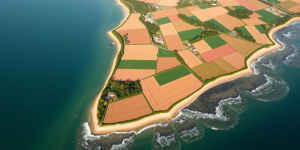The Virginia coast. Think sun-kissed skin, the tang of salt in the air, and the echoes of centuries past. It’s a place that pulls you in, drawing millions every year and fueling a huge chunk of the state’s economy. But beneath the postcard-perfect surface, a threat is rising: sea levels, pushed higher by climate change. Can Virginia adapt quickly enough to save its coastal treasures and the livelihoods that depend on them? It’s a race against the tide.
Virginia’s Coast: More Than Just a Pretty View
From the buzzing boardwalk of Virginia Beach to the historic Northern Neck, coastal tourism isn’t just a pleasant pastime; it’s a financial powerhouse. But what exactly makes this coastline so special?
- Beaches and Water Activities: Think surfing, sunbathing, and casting a line – the classic coastal experience.
- Historical Sites: Jamestown, Yorktown – history comes alive here, drawing visitors eager to walk in the footsteps of the past.
- Natural Beauty: The Chesapeake Bay, a sprawling ecosystem teeming with life, offers everything from birdwatching to kayaking adventures.
- Coastal Cuisine: Forget chain restaurants! Here, it’s all about fresh seafood and local brews, a true taste of the region.
But here’s the kicker: the rising tide is already nipping at the heels of this economic engine. More frequent floods, eroding beaches, and disappearing habitats are impacting everything from tourism to infrastructure.

The Science: It’s Not Just a Theory
The science is clear, almost screaming at us: sea levels are rising, and Virginia’s coast is ground zero. The Virginia Institute of Marine Science (VIMS) warns that some areas are seeing the fastest rates of sea-level rise on the entire Atlantic coast. Why? A double whammy of global sea-level rise and sinking land.
Here’s what the future could hold:
- VIMS forecasts a potential rise of 1.5 to 3 feet in the Hampton Roads area by 2050. That’s less than 30 years away!
- “Nuisance flooding” – those disruptive floods that mess up daily life – are becoming more common.
- Coastal erosion is accelerating, threatening beaches, wetlands, and historical treasures.
These aren’t just numbers on a chart; they’re real-world problems. “We’re seeing more and more days where the streets are flooded,” says a business owner in Chincoteague. “It’s making it tough for tourists, and it’s hitting us where it hurts – our bottom line.”
Lessons from Around the World: What Works?
Virginia isn’t the only one battling the rising tide. Coastal communities worldwide are experimenting with solutions. So, what can we learn from them?
- The Netherlands: These guys are water management pros. Think massive dikes, storm surge barriers, and innovative projects that give rivers room to flow.
- Miami Beach, Florida: They’re throwing money at the problem, raising roads, installing pumps, and building seawalls to keep the water at bay.
- Venice, Italy: The MOSE project – a series of retractable barriers – is designed to protect this iconic city from the highest tides.
But it’s not all about massive engineering projects. Nature-based solutions are also gaining traction. Restoring wetlands, planting mangroves, and creating “living shorelines” can provide natural buffers against storms and erosion.
Virginia Fights Back: A Plan for the Future
Virginia is taking action, but is it enough? Here’s a snapshot of what’s happening:
- The Coastal Resilience Master Plan: A comprehensive strategy that includes infrastructure upgrades, policy changes, and community involvement.
- The Community Flood Preparedness Fund: Grants to help local communities tackle flood mitigation projects.
- Living Shoreline Projects: Efforts to restore wetlands and create those natural buffers we talked about.
The roadblocks? Funding is always tight, and some folks resist changes that might impact property values. A truly effective response demands teamwork between state and local governments, businesses, and everyday citizens.
Voices from the Water’s Edge: Real People, Real Concerns
What’s it really like to live with the threat of rising seas? I talked to people on the coast to get their perspectives.
“The fish are changing,” says a fisherman from the Eastern Shore. “The water’s warmer, and some species are heading north. It’s messing with our catches, plain and simple.”
An environmental scientist with the Chesapeake Bay Foundation stressed the urgency of the situation. “We need to invest in restoring habitats and cleaning up pollution to make the Bay stronger in the face of climate change.”
And a hotel owner in Virginia Beach? “We need to attract tourists, but we also need to protect what makes this place special. It’s a tough balancing act.”
Time to Act: A Coastal Future Worth Fighting For
The future of Virginia’s coast hangs in the balance. It depends on our willingness to adapt, to innovate, and to work together. Here’s what needs to happen:
- More Money: We need to invest in adaptation projects, research, and educating the public.
- Smarter Policies: Zoning laws and building codes need to reflect the reality of rising sea levels.
- Community Power: We need to get everyone on board, from residents to businesses, to understand the risks and the opportunities.
- Embrace Innovation: New technologies and approaches are crucial to protecting our coastlines.
The challenges are real, but so is the potential. By working together, we can protect Virginia’s coastal treasures for the generations to come. We can ensure that the salty air, the sun-drenched beaches, and the echoes of history continue to draw visitors for years to come. But we need to act now, before the rising tide washes away our heritage.


